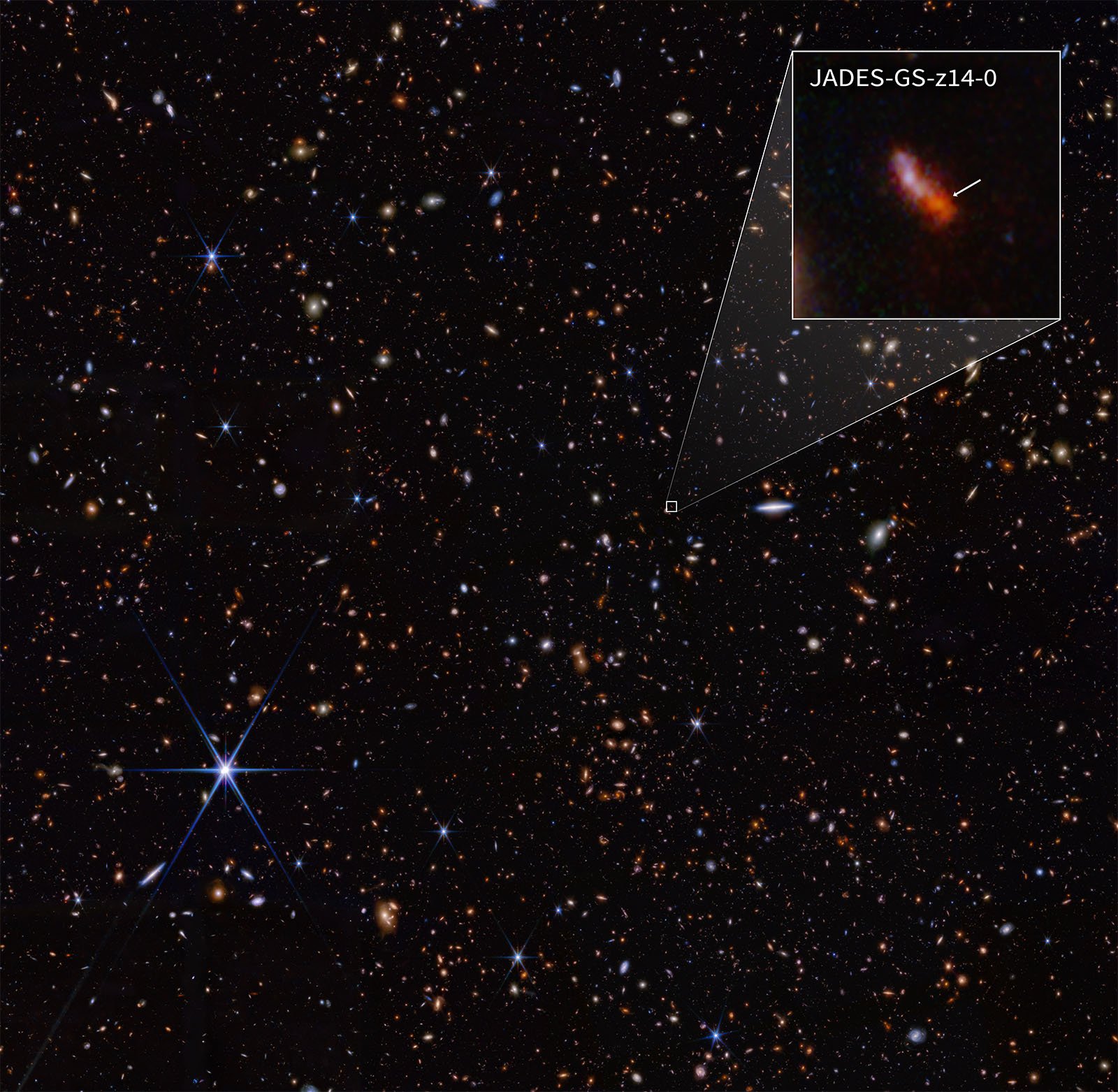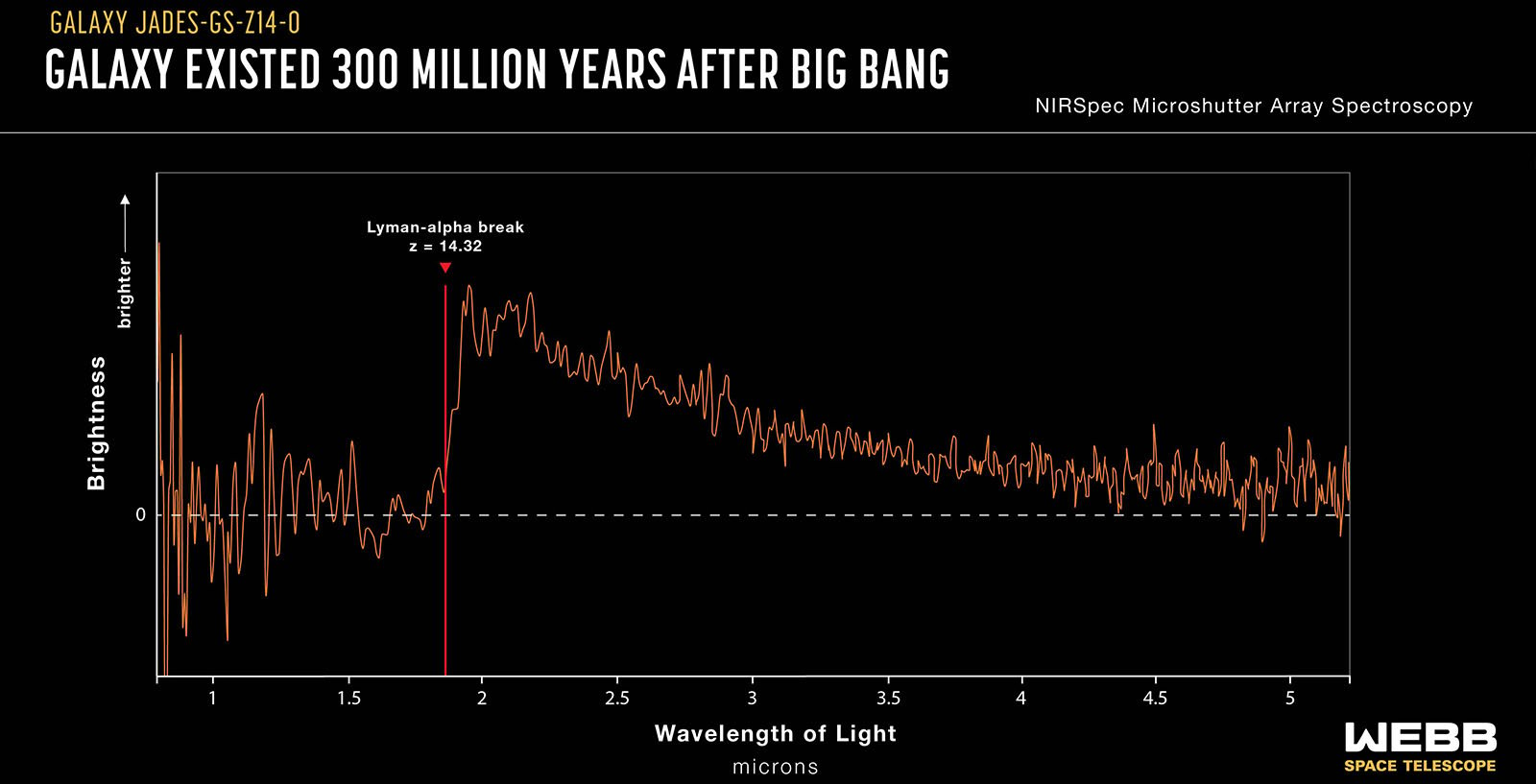![]()
The James Webb Space Telescope (JWST) has been busy peering into the distant reaches of the Universe, otherwise known as the “Cosmic Dawn.” This period when the Universe was only a few hundred million years old is a treasure trove of information about how galaxies evolved when the Universe was very young.
In October 2023 and January 2024, an international team of astronomers used Webb to observe galaxies as part of the JWST Advanced Deep Extragalactic Survey (JADES) program. Using Webb’s Near-Infrared Spectrograph (NIRSpec), the team obtained a spectrum of a record-breaking galaxy observed just 290 million years after the Big Bang.
“In January 2024, NIRSpec observed this galaxy, JADES-GS-z14-0, for almost ten hours, and when the spectrum was first processed, there was unambiguous evidence that the galaxy was indeed at a redshift of 14.32, shattering the previous most-distant galaxy record (z = 13.2 of JADES-GS-z13-0). Seeing this spectrum was incredibly exciting for the whole team, given the mystery surrounding the source,” explain Stefano Carniani and Kevin Hainline.

Beyond the remarkable distance record, the team also determined that the galaxy JADES-GS-z14-0 must be exceptionally bright. The source is over 1,600 light-years across, “proving that the light we see is coming mostly from young stars and not from emission near a growing supermassive black hole.”
For there to be this much starlight, the galaxy must be hundreds of millions of times the mass of the Sun, which then leads to one of the most vital questions astronomers using Webb are trying to answer: “How can nature make such a bright, massive, and large galaxy in less than 300 million years?”
While solving that mystery will require more science, the data offers additional amazing insights. The ancient, distant galaxy is also not as blue as it could be, which provides evidence that some of its light is reddened by dust, even at this very early stage of the Universe.

Jake Helton of Steward Observatory and the University of Arizona used Webb’s Mid-Infrared Instrument (MIRI) to identify JADES-GS-z14-0 at even longer wavelengths, which is a “remarkable achievement considering its distance.” The MIRI observation data includes wavelengths of light within the visible spectrum, although these wavelengths are redshifted outside Webb’s detection capabilities.
Helton’s analysis of the luminance of the object, combined with extrapolations from other Webb observations, shows evidence for the presence of strongly ionized gas emission in the galaxy, showing as emission lines from hydrogen and oxygen. This is another stunning aspect of the discovery, as it suggests that multiple generations of gargantuan stars had already been born and died between the Big Bang and the observations of JADES-GS-z14-0. Put another way, sometime between point zero (the Big Bang), and 290 million years following the Big Bang, stars had come and gone in the region surrounding JADES-GS-z14-0.
![]()
“All of these observations, together, tell us that JADES-GS-z14-0 is not like the types of galaxies that have been predicted by theoretical models and computer simulations to exist in the very early Universe. Given the observed brightness of the source, we can forecast how it might grow over cosmic time, and so far we have not found any suitable analogs from the hundreds of other galaxies we’ve observed at high redshift in our survey,” the researchers explain.
“Given the relatively small region of the sky that we searched to find JADES-GS-z14-0, its discovery has profound implications for the predicted number of bright galaxies we see in the early universe, as discussed in another concurrent JADES study (Robertson et al., recently accepted). It is likely that astronomers will find many such luminous galaxies, possibly at even earlier times, over the next decade with Webb. We’re thrilled to see the extraordinary diversity of galaxies that existed at Cosmic Dawn!”
Image credits: NASA, ESA, CSA, STScI, B. Robertson (UC Santa Cruz), B. Johnson (CfA), S. Tacchella (Cambridge), P. Cargile (CfA). The relevant research is currently undergoing peer review and has been released as part of Webb’s “science in progress” initiative.
